Children, Crime and Consequences
The Agony Column for July 18, 2003
Commentary by Rick Kleffel
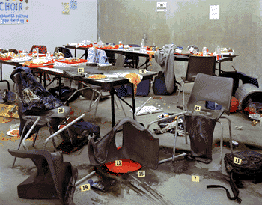
|
|
Douglas Coupland's art work, 'Tropical Birds': "The
instant the fire alarm went dead, Motte heard a strange,
almost surreal sound welling up faintly from inside, like
birds chirping. Across the cafeteria, telephone pagers in
the abandoned backpacks were going off, unanswered calls
from desperate parents."
from the Rocky Mountain News.
|
It took me years to admit to myself that having children had
changed my reading tastes. No longer was I ready to read the kind of
horror that gleefully folded, spindled and mutilated kids along with
adults, pets and evil monsters. Slowly but surely I got a lot pickier
about what I read. But old habits die hard, and as my charming
children mutated into teenagers, I found my threshold rising. No, I
don't think that I could read 'Cujo' again. There are still some
books that I can't bring myself to read, no matter how well liked or
highly recommended they come. But through a recent aberration, I
found myself reading a lot of recent titles that did involve children
in danger and children in the vicinity of crime. It's a genre with a
lot of potential -- to appeal or repel. Sometimes both at once. It's
easy to have mixed feelings.
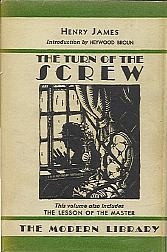
|
|
Henry James plays on the ambiguous perceptions we have
of children in 'The Turn of the Screw'.
|
Now, it's not as if this is a new development. Literature about
children in terror has been used to terrorize children for years.
It's a part of the curriculum and as it happens one of the more
enjoyable slabs of literature shoved down the throats of kids in
school. For myself, I found the touchstones of school-lit terror to
be Henry James 'The Turn of the Screw' and William Golding's 'The
Lord of the Flies'. Henry James' novella was actually the first of
these I encountered. Despite its short length, 'The Turn of the
Screw' actually maps much of the terrain for much of the
child-oriented literature of terror to follow. James is such a
masterful writer that even now, over a hundred years after its
publication, critics are finding nuances that were not obvious. For
me, 'The Turn of the Screw' was a revelation of the power of
ambiguity. Miles and Flora, the two children of Bly are beautiful
blanks upon which the reader, the governess, Douglas and James are
able to project pure goodness and incisive evil. Miles and Flora are
in a quantum state, fluctuating between good and evil from scene to
scene, from reader to writer to narrator. Are they leaking evil or
being polluted by it? James does with children characters what cannot
be done with adults. Adults are finished; they're grown. Children, on
the other hand, may change rapidly, from moment to moment and extreme
to extreme. Are the "ghosts" seen by the governess projections of the
children, or are they affecting the behavior of the children? Are
they working with the children? James' powerfully simple language and
plotting enable him to use the children as portals for a frightening
number of both hopes and fears. If you haven't yet read this novella,
take the time to do so and see where much of today's finest horror
and suspense literature first found a small child's voice.
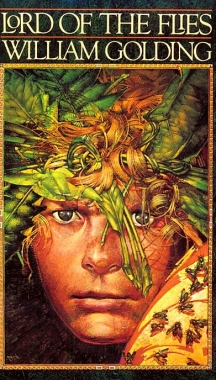
|
|
I had to turn off a recent and very accurate movie
adaptation of this novel.
|
'The Lord of the Flies' pursues another path, just as powerful,
but more directly disturbing and unpleasant. William Golding is
working for something of an opposite effect of James. 'The Lord of
the Flies' puts children in a situation where they are forced to
behave like adults -- or die. It's a frightening and simple formula
that has been copied relentlessly and exploitatively. The original is
still too unpleasant for many a parent to experience. By forcing
children to take on adult behavior, all the horror of that which is
accepted in adults is emphasized by the children. The ugliness of
politics becomes an analogue of bullying. Douglas Coupland recently
told me in an interview about a series of Canadian public service
announcements in which adults are portrayed in the manner of
schoolyard bullies. A man in a suit is shown getting his lunch taken
from him by office bullies, or pushed out of a queue for a train. The
point is that this behavior is unacceptable for adults and should be
unacceptable in children as well. 'Lord of the Flies' reverses that
thought and shows that acceptable behavior for adults is unacceptable
and disturbing when seen in children. The creation of civilization is
an ugly process when seen in miniature. Killing is a lot worse when
it's children killing children as opposed to adults killing adults.
'Lord of the Flies' retains its power because it boils the evil that
men do down the evil that children do.
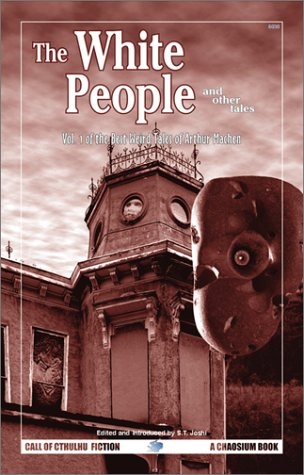
|
|
Machen tapped into the terror of illogic in his story
'The White People'.
|
Arthur Machen, a noted horror writer, also paved the way for
children and evil with his powerful story 'The White People'. Unlike
James and Golding, Machen tells his story from the point of view of
the child. After a brief and very Victorian-style introduction, the
bulk of 'The White People' is the chilling diary of a 13-year old
girl. One day, like all children, she ventures beyond the confines of
her safe world into a world of Faerie. Related in a nearly unbroken
stream of consciousness, Machen's meditation is a powerful picture of
innocence faced with a pure evil, an evil of illogic, an evil of
things that cannot and should not exist. Machen makes excellent use
of a narrator who is experiencing events she cannot quite comprehend,
though she can describe them all too well. Few since have described a
slow conversion from innocence to evil without any recognition of the
process taking place as well as Machen. Guided by a beloved but
sinister (to the reader) "nursie", the narrator experiences anomalies
with expectation. "And there were other rocks that were like animals,
creeping, horrible animals, putting out their tongues, and others
were like words I could not say, and others like dead people lying on
the grass. I went on among them, though they frightened me, and my
heart was full of wicked song they put into it; and I wanted to make
faces and twist myself about the way they did, and I went on and on a
long way till at last I liked the rocks and they didn't frighten me
any more." Though there's a strong supernatural element to 'The White
People', it speaks to a timeless corruption within innocence. It's an
upsetting perception of reality that can bring out the best in
talented writers.
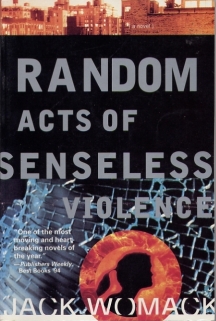
|
|
Jack Womack told me to read this novel of his first.
It's a powerful evocation of a corrupted childhood in a
world frighteningly close to ours.
|
My most recent bout of child-related reading began with Jack
Womack's 'Random
Acts of Senseless Violence'. Womack's vision of a pre-teen girl
who grows into a violent -- but still likable -- killer is even more
powerful now than it was when it was written. Womack created a vision
of the near future that seems contemporary and compelling even though
it was written some ten years ago. But it's the voice of his
narrator, Lola Hart, and her perceptions of her family that lifts
this novel into the stratosphere of fine literature. Lola Hart is a
12-year old girl living with her nuclear family -- her
barely-employed father, her drug-addled mother, and her distant young
sister in a New York on the verge of financial collapse. In the
course of the novel, the Harts lose their small but nice apartment
and are forced to move to a slum, where Lola begins her education in
street life. Womack plays out a voice that reads like a combination
of that of the young girl in Machen's 'The White People' and Alex
from 'A Clockwork Orange'. The world he portrays is our own skewed by
just a couple degrees of chaos and filtered through Lola's changing
eyes. Womack effortlessly captures the changing voice and attitude of
Lola as she finds herself changing to match her new surroundings. He
carefully reflects the apocalypse without by the changes within.
Escalating world events begin in the sidelines but quickly come to
occupy center stage and serving to propel the plot. 'Random Acts of
Senseless Violence' uses a child's voice to describe an adult's
world. It breaks your heart as it tells you how it works.
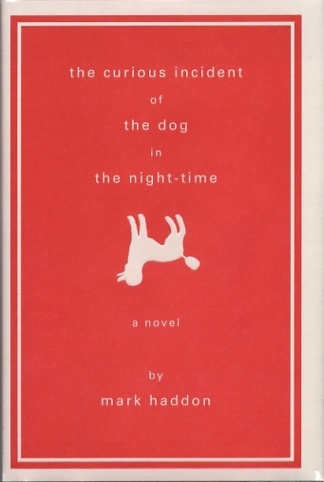
|
|
Mark Haddon's wonderful novel 'the curious incident of
the dog in the night-time' will easily make lots of year's
best lists.
|
Having read 'Random Acts of Senseless Violence', I became
intrigued by the idea of children's place in crime fiction. Yes, I
know 'Random Acts of Senseless Violence' isn't exactly crime fiction,
but that was the phrase that came to me, especially when I first
heard about 'the curious incident of the dog in the night-time' by
Mark Haddon. We have two reviews of this novel, both by myself
and by Terry
D'Auray. We both immensely enjoyed Haddon's masterful novel,
though our takes on why are rather different. But Haddon has utterly
nailed the appeal of the youth in a tale of crime in his first novel
for adults. This novel has a tremendous potential to become a
bestseller, and it deserves to be one. It's funny, touching, powerful
and dense with facts and speculations. The uninformed observations
from a child not capable of emotional connection of the adult world
manage to make everything old new again. Most importantly, it's just
totally readable. Few who pick it up in the store will go home
without it. Haddon's narrator, the 15 year-old Christopher John
Francis Boone is a character that the reader will adore being around.
This brilliantly written, very thin novel will remind you once again
of why it is so much fun to read.
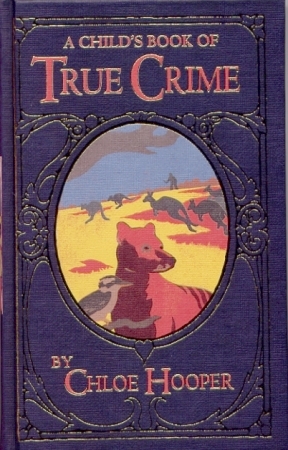
|
|
If you can find a first edition of this novel, it's
worth looking at. Even the US paperback includes the
illustrations fro the hardcover, however.
|
As I was reading Haddon's novel, I was remembering a very
different novel with a very similar title from last year. I didn't
remember the title or author, but I remembered the bookseller who had
recommended it, Michael DeSarno of Legends books. I gave him a call
and as much of a hint as I could and he pointed me to Chloe Hooper's
'A Child's Book
of True Crime'. He still had first editions, so I ordered one up.
Published without a dust jacket, it features a lovely illustration
and a nicely textured surface. It's definitely a book worth owning
for the format, which includes interior illustrations as well.
Hooper's novel is a bit of a mixed bag, depending on your feelings
about erotic literature. Her tale is narrated by a hot-tot-trot
teacher who's having an affair with the father of one of her
students. The man's wife has just written a true crime work about a
jealous wife who brutally murdered her husband's lover then killed
herself -- or perhaps disappeared. When the student's drawings start
to hint at violence, the teacher begins to imagine that she's got
herself into a bad situation.
It's a brilliant setup. Hooper's prose is strong and there are
lots of quotable portions of the narrative. Hooper fills the novel
with fascinating facts about children and violence. Even more
inventively, she writes a children's book that is interspersed in the
narrative, in which cuddly animals try to determine the culprit to
the true crime. She gives the children a strong voice, recounting
discussions about God, life and death that seem authentically
child-like. But her narrator is a bit addled by her attraction to the
father, and the portions of the narrative that follow their
potentially fatal attraction to one another serve only to soften the
focus on the discussions of children and evil. Now, the production of
the first edition of this novel is nothing short of wonderful, and
the questions it raises regarding children's perceptions of violence
and evil are fascinating. The illustrations for the children's novel
are delightful. I'll look very closely at Hooper's next novel. If she
continues to indulge her inclination to the erotic, then I may give
it a pass; if she follows up on her predilection for facts, I'll be
springing for it straight away.
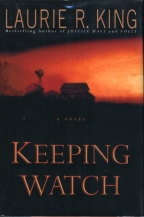
|
|
Laurie King's 'Keeping Watch' contains the origin
story for a character who protects children in danger --
even if they're in danger from other children.
|
Laurie King is noted for a couple of series of detective novels,
but her most recent novel, 'Keeping
Watch' takes her in a new direction. Following one of the
characters from her novel 'Folly', she plays int he same subject as
Henry James, and does so remarkably well. 'Keeping Watch' was a novel
I actually might not have elected to read had I not been asked to
interview the author, as the subject matter is ont he dicey side of
what I think I can tolerate. Allen Carmichael is a fairly wrecked
Vietnam veteran who specializes in rescuing children from abusive
parents. King does an excellent job of creating a man who has been
over the edge and returned able to face situations that many people
-- including myself -- can't face, even in fiction. She describes
with fascinating detail a sort of "underground Railroad" for abused
women and children. She then sends Carmicheal on his resuce mission
-- only to find that the child he may have rescued may be more
dangerous than the abusive father he was recused from. Likie James,
she plays with our ability to perceive a child as a victim one
second, then a perpetrator the next. It's a gripping tale of terror
that never goes so far into pathos as to have the reader rendered
into hopeless sorrow. King plays fair with the mysterious aspects of
her story while giving her characters room to grow and come to life.
It is on the mystery side of the genre gap, but only barely. 'Keeping
Watch' demonstrates that King is capable of mining depths without
plumbing them.
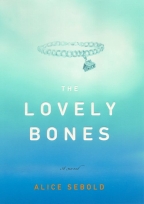
|
|
Alice Sebold tapped into the mainstgream consciousness
with her novel 'The Lovely Bones'. But that doesn't mean
that I can actually make myself read it.
|
I mentioned earlier that there are books I just can't bring myself
to read. Amongst those is 'The Lovely Bones' by Alice Sebold. I met
her while I was interviewing her husband, author
Glen David Gold whose novel 'Carter
Beats the Devil' I just adored. Ms. Sebold was very nice and
wonderfully astute. We talked a bit about the use of supernatural
themes in more mainstream novels, and she suggested some fascinating
books for me to read. I really, really intended to read her novel.
Terry D'Auray went so far as to loan it to my wife and I. But knowing
what was between the covers, I decided to give it a pass. I've been
in the vicinity of events remotely resembling those she describes;
the rape and murder of a teenage girl, and the slowly unraveling
family life that follows. Judging from Terry's
review, I think I made the right decision. While I know for a
fact from both Serena's
review and Terry's review of this novel that it's a powerful and
well-written piece, I also know that the painful place it inhabits is
someplace I can't go as a reader. Make no mistake; when Alice Sebold
writes another novel I'll be first in line. You can also make no
mistake that this novel develops the themes of children, crime and
consequences with a power and craft that's the reading equivalent of
being hit upside the head with a sledgehammer, as artistically as
humanly possible. And make no mistake that if you've not known a
crime victim, you would find this exploration searingly informative.
But if you expect to read this novel and not be moved far beyond your
normal emotional boundaries -- that's a big mistake.
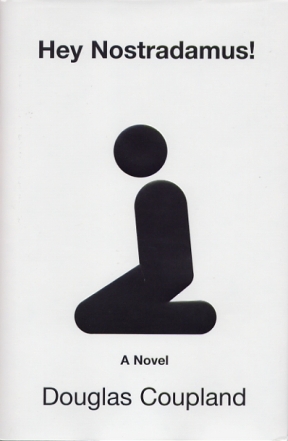
|
|
Coupland's cover evokes the dots and lines behind the
faith of children.
|
Yes, embarrassingly enough, I did ask Douglas Coupland about the
slight similarities between 'The Lovely Bones' and his latest novel,
'Hey
Nostradamus!'. He was lightning quick to correct me; 1), 'Hey
Nostradamus!' was in the mail to the publishers before 'The Lovely
Bones' was released (no surprise there, but) 2) "You haven't read my
other novels, have you?" [Uh, no.] "I've used dead teenagers
as narrators before; this isn't the first time." 'Hey Nostradamus!'
begins with the post-life narration by a 16 year-old girl of a
Columbine-style massacre that takes place in 1988 in a Vancouver high
school. From the beginning, Coupland uses his teenage narrator to get
directly to issues of faith in a way that would not be possible were
she an adult. Her thoughts are a fascinating combination of
matter-of-fact acceptance and naïve belief in the love she
shared with her boyfriend, Jason, to whom she was secretly married.
Coupland leavens his narrative of tragedy and terror with a good deal
of black humor, rendering the novel readable where otherwise it might
not be, by me at least. He also pursues his story in a unique
fashion. He ignores the perpetrators and the police and follows the
victims of the crime. The novel's next section finds Jason, eleven
years later in 1999, leading a rootless but not entirely unhappy
existence. The next section traces the life of Heather, who has tried
to love Jason and become a part of his life. The final section, an
elegiac coda, brings the reader back to Jason's father. Beautiful,
funny and moving -- without ripping out your heart -- 'Hey
Nostradamus!' is a searing look at faith and the lives of the victims
of child-crimes.
All that innocence, wasted, calcified by terror into an acceptance
of the undeniable awfulness of this life. Children who perpetrate
crimes, who are the victims of crimes, children who solve crimes --
there's a howling abyss beneath the flat recitation of what happened.
It's delicate territory, but in the hands of great writers, putting
children in harm's way is the author's way of preventing the horror.
By writing about it, by committing it to paper as fiction, it remains
firmly in the realm of the unreal. We can assimilate it -- or not --
and be changed by the knowledge. Reading can be one of the most
powerful experiences we humans can have. Sometimes we need to pass a
work by, to acknowledge its power but leave it undisturbed. Maybe
someday I can read 'The Lovely Bones'. But not while my kids are
still teenagers.









